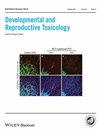Mechanism of Developmental Effects in Rats Caused by an N-Phenylimide Herbicide: Transient Fetal Anemia and Sequelae during Mid-to-Late Gestation.
Q Environmental Science
Birth defects research. Part B, Developmental and reproductive toxicology
Pub Date : 2016-02-01
DOI:10.1002/bdrb.21172
引用次数: 6
Abstract
BACKGROUND Rat developmental toxicity including embryolethality and teratogenicity (mainly ventricular septal defects [VSDs] and wavy ribs) was produced by an N-phenylimide herbicide that inhibits protoporphyrinogen oxidase (PPO) common to chlorophyll and heme biosynthesis. Major characteristics of the developmental toxicity included species difference between rats and rabbits, compound-specific difference among structurally similar herbicides, and sensitive period. Protoporphyrin accumulation in treated fetuses closely correlated with the major characteristics. Iron deposits in erythroblastic mitochondria and degeneration of erythroblasts were observed in treated rat fetuses. In this study we investigated fetal anemia and subsequent developmental effects in rats, and inhibition of PPO in rats, rabbits, and humans by the herbicides in vitro. METHODS Fetuses were treated on gestational day (GD) 12 and removed on GDs 13 through 20. All litters were examined externally. One half of litters were examined for blood and skeletal development, and the other half for interventricular foramen closure. Effects on PPO were determined in mitochondria from embryos and adult livers. RESULTS Fetal anemia in rats was evident on GDs 13 through 16. Subsequently, enlarged heart, delayed closure of the foramen, reduced serum protein, and retarded rib ossification were observed. In vitro PPO inhibition exhibited species- and compound-specific differences corresponding to the developmental toxicity. CONCLUSION We propose that developmental toxicity results from PPO inhibition in primitive erythroblasts, causing transient fetal anemia followed by death. Compensatory enlargement of the fetal heart results in failure of interventricular foramen closure and VSD. Reduced serum protein leads to delayed ossification and wavy ribs.n -苯基亚胺除草剂对大鼠发育影响的机制:妊娠中后期短暂性胎儿贫血和后遗症。
n -苯基亚胺除草剂可抑制叶绿素和血红素生物合成中常见的原卟啉原氧化酶(PPO),从而产生包括胚胎致死性和致畸性(主要是室间隔缺损[VSDs]和波纹肋)的发育毒性。发育毒性的主要特征包括大鼠和家兔的种间差异、结构相似除草剂间化合物特异性差异和敏感期。原卟啉在治疗胎儿中的积累与主要特征密切相关。在处理后的大鼠胎儿中观察到红细胞线粒体中的铁沉积和红细胞变性。在本研究中,我们研究了大鼠胎儿贫血及其对发育的影响,以及除草剂对大鼠、兔和人体内PPO的抑制作用。方法在妊娠第12天对胎儿进行治疗,在妊娠第13 ~ 20天切除胎儿。所有幼崽都进行了外部检查。其中一半进行了血液和骨骼发育检查,另一半进行了室间孔闭合检查。测定了胚胎和成人肝脏线粒体对PPO的影响。结果大鼠胎儿贫血在GDs 13 ~ 16明显。随后,观察到心脏增大,孔关闭延迟,血清蛋白降低,肋骨骨化迟缓。体外PPO抑制表现出与发育毒性相对应的物种和化合物特异性差异。结论:发育毒性是由于原始红母细胞PPO受到抑制,导致胎儿短暂性贫血并死亡。胎儿心脏代偿性增大导致室间隔孔闭合失败和室间隔缺损。血清蛋白降低导致骨化延迟,肋骨呈波浪状。
本文章由计算机程序翻译,如有差异,请以英文原文为准。
求助全文
约1分钟内获得全文
求助全文
来源期刊
CiteScore
1.65
自引率
0.00%
发文量
0
审稿时长
>12 weeks
期刊介绍:
The purpose of this journal is to publish original contributions describing the toxicity of chemicals to developing organisms and the process of reproduction. The scope of the journal will inlcude: • toxicity of new chemical entities and biotechnology derived products to developing organismal systems; • toxicity of these and other xenobiotic agents to reproductive function; • multi-generation studies; • endocrine-mediated toxicity, particularly for endpoints that are relevant to development and reproduction; • novel protocols for evaluating developmental and reproductive toxicity; Part B: Developmental and Reproductive Toxicology , formerly published as Teratogenesis, Carcinogenesis and Mutagenesis

 求助内容:
求助内容: 应助结果提醒方式:
应助结果提醒方式:


